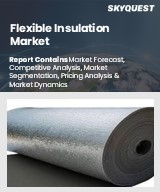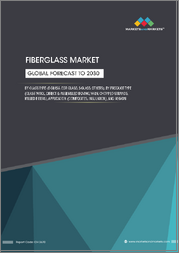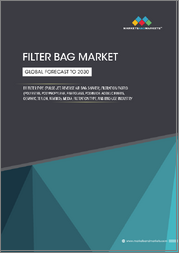
|
시장보고서
상품코드
1623173
세계의 전자 유리섬유 시장 규모 : 제품별, 용도별, 지역별, 범위 및 예측Global Electronic Fiberglass Market Size By Product (E-Glass, Ecr-Glass), By Application (Transportation, Building And Construction), By Geographic Scope And Forecast |
||||||
전자 유리섬유 시장 규모 및 예측
전자 유리섬유 시장 규모는 2020년에 173억 6,000만 달러로 평가되었고, 2021년부터 2028년까지 CAGR 4.90%로 성장할 전망이며, 2028년에는 254억 3,000만 달러에 달할 것으로 예측되고 있습니다.
자동차 산업에서 유리섬유 복합재의 사용 증가와 많은 산업에서 경량 재료 수요 증가가 전자 유리섬유 시장의 성장을 가속하는 요인이 되었습니다. 이 조사 보고서는 전자 유리섬유 시장에 대한 전반적인 평가를 제공합니다. 주요 부문, 동향, 시장 촉진 요인, 경합 정세, 시장에서 중요한 역할을 하고 있는 요인 등을 포괄적으로 분석하고 있습니다.
세계 전자 유리섬유 시장의 정의
E 유리는 당초 전선용 스탠드오프 절연체로 개발되었습니다. 유리섬유는 우수한 섬유형성 능력을 가진 것으로 발견되어 현재는 일반적으로 유리섬유로 알려진 재료의 강화상으로 거의 독점적으로 사용되고 있습니다. 유리섬유는 주로 폴리머 보강에 사용됩니다. 유리섬유의 주요 종류는 E 유리, 고강도 유리, 내식성 유리입니다. 첫 번째 중요한 합성 보강재인 E 유리섬유는 처음에는 전기 절연 용도를 위해 개발되었습니다. E 유리섬유는 섬유상 보강재 중 가장 널리 사용됩니다.
그 주된 이유는 다른 섬유에 비해 저렴한 비용과 개발시기가 빨랐다는 것입니다. 유리섬유는 다섬유 다발 형태로 제조됩니다. E 유리섬유는 다른 보강재에 비해 상대적으로 낮은 탄성률을 가지고 있습니다. 또한 E 유리섬유는 크리프나 파괴의 영향을 받기 쉽습니다. HS 유리는 E 유리보다 단단하고 견고하며 피로와 크리프에 대한 내성이 뛰어납니다. 유리섬유의 열전도율과 전기전도율은 낮으며, 유리섬유 강화PMC는 단열재나 절연재로 일반적으로 사용됩니다. 유리섬유의 CTE도 대부분의 금속보다 낮습니다.
세계의 전자 유리섬유 시장 개요
시장의 성장을 가속하는 주요 요인은 자동차 산업에서 유리 섬유 복합재료 증가, 환경에 대한 관심 증가, 경량 재료 수요입니다. 또한 혁신적인 인프라 건설이 증가하면서 과열을 억제하고 주위 온도를 유지하기 위해 유리섬유가 채택되고 있습니다. 또, 전세계의 많은 정부 기관이, 환경 친화적이고 에너지 효율이 높은 건물의 지속 가능한 개발에 점점 투자하게 되고 있어, 그것이 유리 섬유의 수요를 촉진하고 있습니다.
또한 바닥, 벽, 창문, 패널 등의 기존 건축재료를 유리섬유로 대체하는 리폼과 리모델링도 늘어나고 있습니다. 단열성을 높이고 구조의 안정성을 높이기 위해서입니다. 게다가 신재생 에너지 분야의 현저한 성장이, 풍력이나 조력이라고 하는 깨끗하고 안전한 에너지원을 이용하기 위한 각종 전기 기기를 제조하기 위한 제품 수요를 한층 더 끌어올리고 있습니다.
확대되는 자동차 산업은 저연비 차량에 대한 수요가 증가함에 따라 바디 패널, 대시보드, 대시보드 휠 하우징 어셈블리, 배터리, 전면 크랭크 등의 유리섬유도 증가하고 있습니다. 게다가 수처리나 석유 및 가스 산업에서 파이프라인, 저장 탱크, 해저 시스템에서는, 유리섬유가 금속 베이스의 대체품을 항상 대체하고 있습니다.
시장 성장을 방해하는 요인은 유리섬유 소재를 취급하려면 적절한 일회용 기술이 필요하고, 폐기 처리에 종사하는 인원의 신체적 안전을 위해 마스크와 보호복이 필요하다는 것입니다. 또, 폐기물 관리 정책이나 환경법에 대한 의식의 고조로부터, 자동차, 풍력 터빈, 항공기 등, 내용 연수를 지난 제품으로부터 제조 재료를 적절히 회수해, 재활용하는 것이 요구되고 있습니다. 따라서 글래스 울과 기타 복합재료의 적절한 재활용 기술의 개발은 유리섬유 산업의 지속 가능한 발전에 필수적인 것이 되고 있습니다.
목차
제1장 세계의 전자 유리섬유 시장 : 서문
- 시장 개요
- 조사 범위
- 전제조건
제2장 주요 요약
제3장 검증된 시장 조사의 조사 방법
- 데이터 마이닝
- 밸리데이션
- 1차 자료
- 데이터 소스 일람
제4장 세계의 전자 유리섬유 시장 전망
- 개요
- 시장 역학
- 성장 촉진요인
- 억제요인
- 기회
- Porter's Five Forces 모델
- 밸류체인 분석
제5장 세계의 전자 유리섬유 시장 : 제품별
- 개요
- E 유리
- Ecr 유리
- H 유리
- Ar 유리
- S 유리
- 기타
제6장 세계의 전자 유리섬유 시장 : 용도별
- 개요
- 수송
- 건축 및 건설
- 전기 및 전자
- 파이프 및 탱크
- 소비재
- 풍력에너지
- 기타
제7장 세계의 전자 유리섬유 시장 : 지역별
- 개요
- 북미
- 미국
- 캐나다
- 멕시코
- 유럽
- 독일
- 영국
- 프랑스
- 기타 유럽
- 아시아태평양
- 중국
- 일본
- 인도
- 기타 아시아태평양
- 세계 기타 지역
- 라틴아메리카
- 중동 및 아프리카
제8장 세계의 전자 유리섬유 시장 : 경쟁 구도
- 개요
- 각사 시장 랭킹
- 주요 발전 전략
제9장 기업 프로파일
- Porcher Industries
- Hexcel
- JSC 'Polotsk-Steklovolokno'
- Nittobo
- Arisawa Manufacturing
- AGY
- PPG
- Saint-Gobain
- Taishan Fiberglass
- Jushi Group
제10장 부록
- 관련 조사
Electronic Fiberglass Market Size And Forecast
Electronic Fiberglass Market size was valued at USD 17.36 Billion in 2020 and is projected to reachUSD 25.43 Billion by 2028, growing at aCAGR of 4.90% from 2021 to 2028.
The rise in the use of fiberglass composites in the automotive industry with an increase in demand for lightweight material across many industries is the factor driving the market growth of the Electronic Fiberglass Market. The Global Electronic Fiberglass Market report provides a holistic evaluation of the market. The report offers a comprehensive analysis of key segments, trends, drivers, restraints, competitive landscape, and factors that are playing a substantial role in the market.
Global Electronic Fiberglass Market Definition
E-Glass was initially developed for standoff insulators for electric wires. It has been found to have excellent fiber-forming ability and is now used almost exclusively as a reinforcing phase of the material commonly known as fiberglass. Glass fibers are mainly used to reinforce polymers. The main types of fiberglass are E glass, high strength glass, and corrosion resistant glass. The first significant synthetic reinforcement, E-glass fiber, was initially developed for electrical insulating applications. E glass fibers are the most widely used of all fibrous reinforcements by several orders of magnitude.
The main reasons for this are low cost and early development compared to other fibers. Fiberglass is produced in the form of multi-fiber bundles. Fiberglass e has a relatively low modulus of elasticity compared to other reinforcements. In addition, E-glass fibers are susceptible to creep and fracture. HS glass is stiffer and more robust than E-glass and has better resistance to fatigue and creep. The thermal and electrical conductivity of glass fiber is low, and glass fiber reinforced PMC is commonly used as a heat insulator and insulator. The CTE of fiberglass is also lower than that of most metals.
Global Electronic Fiberglass Market Overview
The primary factor driving the market growth is the rise in fiberglass composites in the automotive industry, increasing environmental concerns, and demand for lightweight materials. Moreover, the increasing construction of innovative infrastructure and the adoption of fiberglass to control overheating and maintain ambient temperature. Also, many government agencies around the globe are increasingly investing in the sustainable development of green and energy-efficient buildings, thereby driving the demand for fiberglass.
In addition, an increasing number of remodeling and remodeling operations have replaced conventional building materials with fiberglass in floors, walls, windows, and panels. To provide better insulation and increase structural stability. In addition, the significant growth in the renewable energy sector further drives the demand for products to manufacture various electrical equipment to harness clean and safe energy sources such as wind and tides.
The expanding automotive industry, coupled with the growing demand for fuel-efficient vehicles, also increases fiberglass in body panels, dashboards, and dashboards-wheel housing assembly, battery, front crank, etc. In addition, fiberglass is constantly replacing metal-based substitutes in pipelines, storage tanks, and undersea systems in water treatment and oil and gas industries.
The factor hampering the market growth is appropriate single-use techniques are required to handle vitreous-wool materials, masks, and protective clothing for the physical safety of personnel involved in the disposal process. In addition, increasing awareness of waste management policies and environmental legislation now requires manufactured materials to be properly recovered and recycled from products such as automobiles, Wind turbines, and aircraft that have passed their useful life. Therefore, the development of suitable recycling technologies for glass wool and other composite materials becomes essential for the sustainable development of the fiberglass industry.
Global Electronic Fiberglass Market: Segmentation Analysis
The Global Electronic Fiberglass Market is Segmented on the basis of Product, Application, And Geography.
Electronic Fiberglass Market, By Product
- E-Glass
- Ecr-Glass
- H-Glass
- Ar-Glass
- S-Glass
- Others
Based on Product, The market is segmented into E-Glass, Ecr-Glass, H-Glass, Ar-Glass, S-Glass, and Others. The E-glass segment holds a large number of shares in the market because electronic glass products are particularly resistant to wear and vibration and have excellent flexibility. Widely used in marine, industrial and aerospace applications, this fabric is lightly woven. E-glass material is considered the industry standard and is cost-effective. Increased use of eco-friendly boron-free fibers is the factor that boosts the market growth of the Electronic Fiberglass Market.
Electronic Fiberglass Market, By Application
- Transportation
- Building And Construction
- Electrical And Electronics
- Pipe And Tank
- Consumer Goods
- Wind Energy
- Others
Based on Application, The market is segmented into Transportation, Building And Construction, Electrical And Electronics, Pipe And Tank, Consumer Goods, Wind Energy, Others. The Transportation segment holds a large number of shares in the market because of government regulations on OEMs to contain lightweight materials to lower the vehicle's overall weight, increasing construction activities in developing countries, and the growing use of insulation per unit building industry, which is the factor that boosts the market growth of the Electronic Fiberglass Market.
Electronic Fiberglass Market, By Geography
- North America
- Europe
- Asia Pacific
- Rest of the world
- On the basis of Geography, The Electronic Fiberglass Market is classified into North America, Europe, Asia Pacific, and the Rest of the world. The Asia Pacific region holds a large number of shares in the market because of the increasing demand for fiberglass with the increase in focus on emission control guidelines. The rising demand for eco-friendly products with an increase in technological advancements in composites. The changing of conventional materials, like steel and aluminum, with fiberglass is the factor that propels the market growth of the Electronic Fiberglass Market.
Key Players
- The "Global Electronic Fiberglass Market" study report will provide a valuable insight with an emphasis on the global market including some of the major players such as
- Porcher Industries, Hexcel, JSC "Polotsk-Steklovolokno", Nittobo, Arisawa Manufacturing, AGY, PPG, Saint-Gobain, Taishan Fiberglass and Jushi Group.
Our market analysis also entails a section solely dedicated to such major players wherein our analysts provide an insight into the financial statements of all the major players, along with its product benchmarking and SWOT analysis. The competitive landscape section also includes key development strategies, market share, and market ranking analysis of the above-mentioned players globally.
Key Developments
- In August 2020, National Composites acquired Sunrise Fiberglass, a multi-plant OEM supplier of bespoke fiber-reinforced plastic and thermoformed products. National Composites delivers four strategically placed plants in the Midwest, individually with various capabilities and manned by proficient fiberglass professionals with comprehensive expertise.
- Report Scope
- REPORT ATTRIBUTES
- DETAILSBASE YEAR
- STUDY PERIOD
2017-2028
- BASE YEAR
2020
- FORECAST PERIOD
2021-2028
- HISTORICAL PERIOD
2017-2019
- UNIT
- Value (USD Billion)
- KEY COMPANIES PROFILED
- Porcher Industries, Hexcel, JSC "Polotsk-Steklovolokno", Nittobo, Arisawa Manufacturing, AGY, PPG, Saint-Gobain, Taishan Fiberglas.
- SEGMENTS COVERED
- By Product
- By Application
- By Geography
- CUSTOMIZATION SCOPE
- Free report customization (equivalent to up to 4 analysts' working days) with purchase. Addition or alteration to country, regional & segment scope.
- Top Trending Reports
Global Electronic Design Automation Tools (EDA) Market Size And Forecast
Global Pediatric Training Manikins Market Size And Forecast
- Research Methodology of Verified Market Research:
- To know more about the Research Methodology and other aspects of the research study, kindly get in touch with our
- Sales Team at Verified Market Research.
- Reasons to Purchase this Report
- Qualitative and quantitative analysis of the market based on segmentation involving both economic as well as non-economic factors
- Provision of market value (USD Billion) data for each segment and sub-segment
- Indicates the region and segment that is expected to witness the fastest growth as well as to dominate the market
- Analysis by geography highlighting the consumption of the product/service in the region as well as indicating the factors that are affecting the market within each region
- Competitive landscape which incorporates the market ranking of the major players, along with new service/product launches, partnerships, business expansions, and acquisitions in the past five years of companies profiled
- Extensive company profiles comprising of company overview, company insights, product benchmarking, and SWOT analysis for the major market players
- The current as well as the future market outlook of the industry with respect to recent developments which involve growth opportunities and drivers as well as challenges and restraints of both emerging as well as developed regions
- Includes in-depth analysis of the market of various perspectives through Porter's five forces analysis
- Provides insight into the market through Value Chain
- Market dynamics scenario, along with growth opportunities of the market in the years to come
- 6-month post-sales analyst support
- Customization of the Report
- In case of any
- Queries or Customization Requirements
Frequently Asked Questions
What is the projected market size & growth rate of the Electronic Fiberglass Market?
- Electronic Fiberglass Market was valued at USD 17.36 Billion in 2020 and is projected to reach USD 25.43 Billion by 2028, growing at a CAGR of 4.90% from 2021 to 2028.
What are the key driving factors for the growth of the Electronic Fiberglass Market?
- The rise in the use of fiberglass composites in the automotive industry with an increase in demand for lightweight material across many industries is the factor driving the market growth of the Electronic Fiberglass Market.
What are the top players operating in the Electronic Fiberglass Market?
- The major players are Porcher Industries, Hexcel, JSC "Polotsk-Steklovolokno", Nittobo, Arisawa Manufacturing, AGY, PPG, Saint-Gobain, Taishan Fiberglass, and Jushi Group.
What segments are covered in the Electronic Fiberglass Market Report?
- The Global Electronic Fiberglass Market is Segmented on the basis of Product, Application, And Geography.
TABLE OF CONTENTS
1 INTRODUCTION OF GLOBAL ELECTRONIC FIBERGLASS MARKET
- 1.1 Overview of the Market
- 1.2 Scope of Report
- 1.3 Assumptions
2 EXECUTIVE SUMMARY
3 RESEARCH METHODOLOGY OF VERIFIED MARKET RESEARCH
- 3.1 Data Mining
- 3.2 Validation
- 3.3 Primary Interviews
- 3.4 List of Data Sources
4 GLOBAL ELECTRONIC FIBERGLASS MARKET OUTLOOK
- 4.1 Overview
- 4.2 Market Dynamics
- 4.2.1 Drivers
- 4.2.2 Restraints
- 4.2.3 Opportunities
- 4.3 Porters Five Force Model
- 4.4 Value Chain Analysis
5 GLOBAL ELECTRONIC FIBERGLASS MARKET, BY PRODUCT
- 5.1 Overview
- 5.2 E-Glass
- 5.3 Ecr-Glass
- 5.4 H-Glass
- 5.5 Ar-Glass
- 5.6 S-Glass
- 5.7 Others
6 GLOBAL ELECTRONIC FIBERGLASS MARKET, BY APPLICATION
- 6.1 Overview
- 6.2 Transportation
- 6.3 Building And Construction
- 6.4 Electrical And Electronics
- 6.5 Pipe And Tank
- 6.6 Consumer Goods
- 6.7 Wind Energy
- 6.8 Others
7 GLOBAL ELECTRONIC FIBERGLASS MARKET, BY GEOGRAPHY
- 7.1 Overview
- 7.2 North America
- 7.2.1 U.S.
- 7.2.2 Canada
- 7.2.3 Mexico
- 7.3 Europe
- 7.3.1 Germany
- 7.3.2 U.K.
- 7.3.3 France
- 7.3.4 Rest of Europe
- 7.4 Asia Pacific
- 7.4.1 China
- 7.4.2 Japan
- 7.4.3 India
- 7.4.4 Rest of Asia Pacific
- 7.5 Rest of the World
- 7.5.1 Latin America
- 7.5.2 Middle East and Africa
8 GLOBAL ELECTRONIC FIBERGLASS MARKET COMPETITIVE LANDSCAPE
- 8.1 Overview
- 8.2 Company Market Ranking
- 8.3 Key Development Strategies
9 COMPANY PROFILES
- 9.1 Porcher Industries
- 9.1.1 Overview
- 9.1.2 Financial Performance
- 9.1.3 Product Outlook
- 9.1.4 Key Developments
- 9.2 Hexcel
- 9.2.1 Overview
- 9.2.2 Financial Performance
- 9.2.3 Product Outlook
- 9.2.4 Key Developments
- 9.3 JSC "Polotsk-Steklovolokno"
- 9.3.1 Overview
- 9.3.2 Financial Performance
- 9.3.3 Product Outlook
- 9.3.4 Key Developments
- 9.4 Nittobo
- 9.4.1 Overview
- 9.4.2 Financial Performance
- 9.4.3 Product Outlook
- 9.4.4 Key Developments
- 9.5 Arisawa Manufacturing
- 9.5.1 Overview
- 9.5.2 Financial Performance
- 9.5.3 Product Outlook
- 9.5.4 Key Developments
- 9.6 AGY
- 9.6.1 Overview
- 9.6.2 Financial Performance
- 9.6.3 Product Outlook
- 9.6.4 Key Developments
- 9.7 PPG
- 9.7.1 Overview
- 9.7.2 Financial Performance
- 9.7.3 Product Outlook
- 9.7.4 Key Developments
- 9.8 Saint-Gobain
- 9.8.1 Overview
- 9.8.2 Financial Performance
- 9.8.3 Product Outlook
- 9.8.4 Key Developments
- 9.9 Taishan Fiberglass
- 9.9.1 Overview
- 9.9.2 Financial Performance
- 9.9.3 Product Outlook
- 9.9.4 Key Developments
- 9.10 Jushi Group
- 9.10.1 Overview
- 9.10.2 Financial Performance
- 9.10.3 Product Outlook
- 9.10.4 Key Developments
10 Appendix
- 10.1 Related Research



















